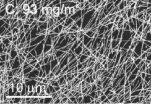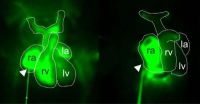(Press-News.org) FAIRFAX, Va.—The first outcome-based guidelines for interventional treatment of acute ischemic stroke—providing recommendations for rapid treatment—will benefit individuals suffering from brain attacks, often caused by artery-blocking blood clots. Representatives from the Society of Interventional Radiology and seven other medical societies created a multispecialty and international consensus on the metrics and benchmarks for processes of care and technical and clinical outcomes for stroke patients.
In February, the guidelines will be published first in SIR's Journal of Vascular and Interventional Radiology and subsequently by each society either in its respective journal or on its website.
"These groundbreaking guidelines are the product of two years of collaboration among multidisciplinary teams from eight societies," said Marshall E. Hicks, M.D., FSIR, president of the Society of Interventional Radiology, the national society of nearly 5,000 doctors, scientists and allied health professionals dedicated to improving health care through minimally invasive treatments. "With real progress being made in research and treatment of stroke over the last decade, this distinguished group of international authors—from societies whose members perform minimally invasive stroke treatments—felt that the time was right for a consensus on how to effectively treat and manage stroke patients," said Hicks, the head of the division of diagnostic imaging at the University of Texas MD Anderson Cancer Center in Houston.
"The one constant in stroke treatment is time," noted David Sacks, M.D., FSIR, an interventional radiologist at Reading Hospital and Medical Center in West Reading, Pa., and the study's lead author. "Seconds count from time of admission to treatment. Meeting the outcomes described in these guidelines will ultimately benefit patients by requiring strict adherence to a rapid treatment schedule," he added. Stroke is the fourth leading cause of adult death and disability in the United States and the third leading cause of death in Canada, Europe and Japan.
The guidelines recommend submission of outcomes to a national registry that will allow research and also comparisons between facilities. Sacks noted that the benchmarks in the paper are intended to be used in a quality assurance program to assess and improve processes and outcomes in acute stroke revascularization, which is the opening of a blocked artery to the brain. He said that the guidelines may also be helpful to facilities that are interested in applying for accreditation as a comprehensive stroke center. "As the field of stroke revascularization evolves, the guidelines will be revised as needed," he added.
In 2003, the Journal of Vascular and Interventional Radiology published a joint society document to guide the design and reporting of stroke research; the new guidelines address clinical care. The co-authors completed a review of the relevant literature from 1986 through February 2012 as the basis for creating performance metrics and thresholds. "All society representatives vigorously discussed each issue based on the literature review and personal experience," said Sacks.
###
The co-authors of "Multisociety Consensus Quality Improvement Guidelines for Intra-arterial Catheter Directed Treatment of Acute Ischemic Stroke" include David Sacks, M.D. FSIR, and M.J.B. Stallmeyer, M.D. (Society of Interventional Radiology); Carl M. Black, M.D. (American Society of Neuroradiology); Christophe Cognard, M.D. (European Society of Minimally Invasive Neurologic Therapy); J.J. (Buddy) Connors III, M.D., FSIR (American Society of Neuroradiology); Donald F. Frei Jr., M.D. (Society of NeuroInterventional Surgery); Rishi Gupta, M.D. (Society of Vascular and Interventional Neurology); Tudor G. Jovin, M.D. (Society of Vascular and Interventional Neurology); Bryan W. Kluck, D.O. ((Society for Cardiovascular Angiography and Interventions); Philip M. Meyers, M.D. (Society of NeuroInterventional Surgery); Kieran J. Murphy, M.D., FSIR (Canadian Interventional Radiology Association); Stephen R. Ramee, M.D. (Society for Cardiovascular Angiography and Interventions) and Daniel A. Rufenacht, M.D. (Cardiovascular and Interventional Radiological Society of Europe).
More information about the Society of Interventional Radiology, interventional radiologists and how to find an interventional radiologist in your area can be found online at www.SIRweb.org.
About the Society of Interventional Radiology
Interventional radiologists are physicians who specialize in minimally invasive, targeted treatments. They offer the most in-depth knowledge of the least invasive treatments available coupled with diagnostic and clinical experience across all specialties. They use X-ray, MRI and other imaging to advance a catheter in the body, such as in an artery, to treat at the source of the disease internally.
As the inventors of angioplasty and the catheter-delivered stent, which were first used in the legs to treat peripheral arterial disease, interventional radiologists pioneered minimally invasive modern medicine. Today, interventional oncology is a growing specialty area of interventional radiology. Interventional radiologists can deliver treatments for cancer directly to the tumor without significant side effects or damage to nearby normal tissue.
Many conditions that once required surgery can be treated less invasively by interventional radiologists. Interventional radiology treatments offer less risk, less pain and less recovery time compared to open surgery. This year, SIR celebrates 40 years of innovation and advances in interventional radiology. Visit www.SIRweb.org.
Medical societies unite on patient-centered measures for nonsurgical stroke interventions
Society of Interventional Radiology publishes guidelines that capture consensus on clinical practice of intra-arterial stroke revascularization, recommend national stroke outcomes registry
2013-01-29
ELSE PRESS RELEASES FROM THIS DATE:
New options for transparent contact electrodes
2013-01-29
This press release is available in German.
Found in flat screens, solar modules, or in new organic light-emitting diode (LED) displays, transparent electrodes have become ubiquitous. Typically, they consist of metal oxides like In2O3, SnO2, ZnO and TiO2.
But since raw materials like indium are becoming more and more costly, researchers have begun to look elsewhere for alternatives. A new review article by HZB scientist Dr. Klaus Ellmer, published in the renowned scientific journal Nature Photonics, is hoping to shed light on the different advantages and disadvantages ...
Epigenetic control of cardiogenesis
2013-01-29
This press release is available in German.
Many different tissues and organs form from pluripotent stem cells during embryonic development. To date it had been known that these processes are controlled by transcription factors for specific tissues. Scientists from the Max Planck Institute for Molecular Genetics in Berlin, in collaboration with colleagues at MIT and the Broad Institute in Boston, have now been able to demonstrate that RNA molecules, which do not act as templates for protein synthesis, participate in these processes as well. The scientists knocked down ...
New insights into conquering influenza
2013-01-29
As influenza spreads through the northern hemisphere winter, Dr Linda Wakim and her colleagues in the Laboratory of Professor Jose Villadangos from the Department of Biochemistry and Molecular Biology, and the Department of Microbiology and Immunology, believe they have a new clue to why some people fight infections better than others.
The lab has been investigating the 'defensive devices' contained within the T- cells that are located on exposed body surfaces such as skin and mucosal surfaces to ward off infection. T-cells detect cells infected with viruses and kill ...
Survival of the prettiest: Sexual selection can be inferred from the fossil record
2013-01-29
Detecting sexual selection in the fossil record is not impossible, according to scientists writing in Trends in Ecology and Evolution this month, co-authored by Dr Darren Naish of the University of Southampton.
The term "sexual selection" refers to the evolutionary pressures that relate to a species' ability to repel rivals, meet mates and pass on genes. We can observe these processes happening in living animals but how do palaeontologists know that sexual selection operated in fossil ones?
Historically, palaeontologists have thought it challenging, even impossible, ...
New insights into managing our water resources
2013-01-29
Dr Tim Peterson, from the School of Engineering at the University of Melbourne has offered new theories that will lead to a deeper knowledge of how water catchments behave during wet and dry years. His research was published recently in the leading international hydrology journal "Water Resources Research" and was selected by the American Geophysical Union as a highlight of the society's 13 international journals.
Dr Peterson's work shows that some catchments have a finite resilience to wet and dry years because they have two steady states. The traditionally held view ...
Study reveals 2-fold higher incidence of non-melanoma skin cancers for HIV patients
2013-01-29
OAKLAND, Calif., January 29 — HIV-positive patients have a higher incidence of non-melanoma skin cancers, according to a Kaiser Permanente study that appears in the current online issue of the Journal of the National Cancer Institute. Specifically, basal cell and squamous cell carcinomas occur more than twice as often among HIV-positive individuals compared to those who are HIV-negative.
The study cohort of 6,560 HIV-positive and almost 37,000 HIV-negative subjects was drawn from members of Kaiser Permanente Northern California from 1996 to 2008.
Overall, HIV-positive ...
Indoor air puts Chinese women nonsmokers at risk
2013-01-29
BUFFALO, N.Y. – The hazards of breathing outdoor air in some Chinese cities have been well-documented. Now a University at Buffalo study confirms that breathing indoor air also carries significant cancer risks, especially for Chinese women.
The UB study, published online this month, in the journal Cancer Causes & Control, found that indoor air pollution that generates fine particulate matter is a key contributor to the high rates of lung cancer among Chinese women, despite the fact that few of them smoke.
The research found indoor particulate matter levels that are ...
Researchers generate a mutant mouse model useful in the treatment of neuromuscular diseases
2013-01-29
In three to six months of life, this genetic alteration in mice –similar to that occurred in human– causes a rapid degeneration in the lower limbs to death for cardiac arrest.
For the first time in the world, researchers at the Center for Biomedical Research of the University of Granada have created mice with a genetic mutation inducing a deficiency in the coenzyme Q10, a rare mitochondrial disease prevailingly affecting children. These mutant mice –which lack the Coq9 gene– will be "a valuable tool for the study and treatment of metabolic encephalopathies and neuromuscular ...
Center-based child care: Long hours do not cause aggression and disobedience
2013-01-29
Spending many hours in centre-based child care does not lead to more aggression and disobedience in children, according to a new study using data from the Norwegian Mother and Child Cohort Study (MoBa).
Data from 72,000 mothers and their children, including siblings, were obtained from MoBa. Using questionnaires, mothers were asked about aggression and obedience at both 18 and 36 months and the amount of time their children spent in child care. In addition to comparing children from different families, the researchers compared siblings who had different amounts of child ...
Satellite visualization tool for high-res observation accessible from anywhere with internet access
2013-01-29
Amsterdam, January 29, 2013 – A paper published in the February issue of Computers & Geosciences, describes a case study in which an earth-observing satellite tool, the Tool for High-Resolution Observation Review (THOR), using minimal coding effort, is converted into a practical web-based application, THOR-Online. In addition, a 3D visualization technique is also described in this paper.
Initially only operable from a desktop computer, with the approach outlined in the study, THOR is now accessible online from NASA's Precipitation Processing System website. This allows ...
LAST 30 PRESS RELEASES:
Fertility remains high in rural Tanzania despite access to family planning
AI-assisted device can improve autism care access
Kinetic careers
Uncovering how parasitic plants avoid attacking themselves to improve crop resistance
Nanoparticle vaccine strategy could protect against Ebola and other deadly filoviruses
Study finds brain care score can predict risk of stroke across racial groups
Key lung immune cells can intensify allergic reactions
Do hormones explain why women experience more gut pain?
New materials conduct ions in solids as easily as in liquids
Breakthrough of the Year: Renewable energy begins to eclipse fossil fuel-based sources
LLM use is reshaping scientific enterprise by increasing output, reducing quality and more
Introducing LightGen, a chip for ultra-fast, ultra-efficient generative AI
Astronomers see fireworks from violent collisions around nearby star
ACC/AHA issue new guideline on managing congenital heart disease in adults
Cosmic crash caught on camera
Is talented youth nurtured the wrong way? New study shows: top performers develop differently than assumed
Ants: An untapped resource in the development of antibiotics?
Archaeologists use AI to create prehistoric video game
Mitochondria migrate toward the cell membrane in response to high glucose levels
Tiny viral switch offers hope against drug-resistant bacteria
Most parents aware of early peanut introduction guidelines, but confused about details
HPV vaccine can protect against severe lesions of the vulva and vagina
Virtual care provision and emergency department use among children and youth
Quadrivalent HPV vaccine and high-grade vulvovaginal lesions
Insights into dry eyes gained from stem cell-derived tear glands
Researchers identify 166 human pluripotent stem cell lines available for use in clinical applications
Europa Clipper instrument uniquely observed interstellar comet 3I/ATLAS
UN University Report challenges climate change as sole trigger of Syrian Civil War, exposing governance failures in drought response
Real estate investment trust (REIT) acquisition associated with hospital closure and bankruptcy
New Raman imaging system detects subtle tumor signals
[Press-News.org] Medical societies unite on patient-centered measures for nonsurgical stroke interventionsSociety of Interventional Radiology publishes guidelines that capture consensus on clinical practice of intra-arterial stroke revascularization, recommend national stroke outcomes registry



